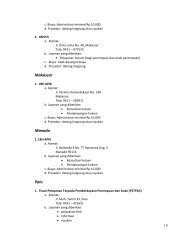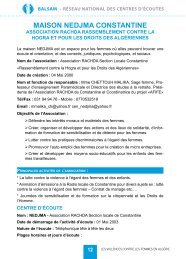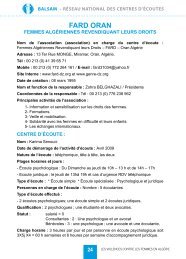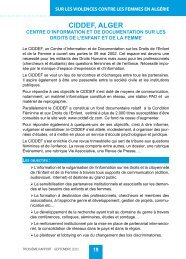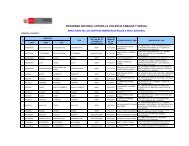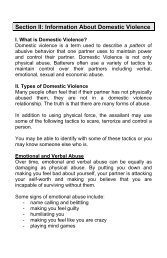Dwa Fanm - Hot Peach Pages
Dwa Fanm - Hot Peach Pages
Dwa Fanm - Hot Peach Pages
Create successful ePaper yourself
Turn your PDF publications into a flip-book with our unique Google optimized e-Paper software.
Produced by <strong>Dwa</strong> <strong>Fanm</strong>. P.O. Box 23505. Brooklyn, NY 11215. 718-230-4027. F: 718-230-3194. www.dwafan.orgPOWER AND CONTROL TACTICS USED AGAINST IMMIGRANT WOMENThe following describes some of the ways in which immigrant women are abused, although the experiences ofindividual victims will vary from case to case.EMOTIONAL ABUSE:Lying about her immigration status.Telling her family in her home country lies about her.Calling her racist names or names regarding her skin colour or skin tone.Belittling and embarrassing her in front of family and friends.Causing her to lose face.Telling her that she has abandoned her culture and become "American".Preventing her from visiting sick or dying relatives in her country.Abuser lying about his ability to have the immigration status of his lawful permanent resident abuse victimschanged.ECONOMIC ABUSE:Forcing her to work "illegally" when she does not have a work permit.Threatening to report her to INS if she works "under the table."Not letting her get job training or schooling.Taking the money her family back home were depending upon her to send them.Forcing her to sign papers in English that she does not understand -court papers, IRS forms, immigration papers.Harassing her at the only job she can work at legally in the U.S., so that she loses that job.SEXUAL ABUSE:Calling her a prostitute.Accusing her of trying to attract other men when she puts on make-up to go to work.Accusing her of sleeping with other men.Alleging that she has a history of prostitution on legal papers.Telling her that "as a matter of law" in the United States that she must continue to have sex with him whenever hewants until they are divorced.USING COERCION AND THREATS:Threatening to report her to INS and get her deported.Threatening that he will not file immigration papers to legalize her immigration status.Threatening to withdraw the petition he filed to legalize her immigration status.Telling her that he will harm someone in her family.Telling her that he will have someone harm her family members in her home country.Threatening to harm or harass her employer or co-workers.USING CHILDREN:Threatening to remove her children from the United States.Threatening to report her children to the INS.Taking the money she was to send to support her children in her home country.Telling her he will have her deported and he will keep the children with him in the U.S.Convincing her that if she seeks help from the courts or the police the U .S. legal system willgive him custody of the children. (In many countries men are given legal control over the children1
and he convinces her that the same will occur here).USING CITIZENSHIP OR RESIDENCY PRIVILEGE:Failing to file papers to legalize her immigration status.Withdrawing or threatening to withdraw immigration papers filed for her residency.Controlling her ability to work.Using the fact of her undocumented immigration status to keep her from reporting abuse or leaving with thechildren.Telling her that the police will arrest her for being undocumented if she calls the police for help because of theabuse.INTIMIDATION:Hiding or destroying important papers (i.e. her passport, her children's passports, ID cards, health care cards, etc.)Destroying the only property that she brought with her from her home country.Destroying photographs of her family members.Threatening persons who serve as a source of support for her.Threatening to do or say something that will shame her family or cause them to lose face. Threatening to divulgefamily secrets.ISOLATION:Isolating her from friends, or family members.Isolating her from persons who speak her language.Not allowing her to learn English or not allowing her to communicate in a language she is fluent in.Being the only person through whom she can communicate in English.Reading her mail and not allowing her to use the telephone.Strictly time all her grocery trips and other travel times.Not allowing her to continue to meet with social workers and other support persons.Not allowing her to meet with people who speak her language or who are from her community, culture or country .MINIMIZING, DENYING, BLAMING:Convincing her that his violent actions are not criminal unless they occur in public. Telling her that he is allowed tophysically punish her because he is the "man."Blaming her for the breakup of the family, if she leaves him because of the violence.Telling her that she is responsible for the violence because she did not do as he wished.2
Produced by <strong>Dwa</strong> <strong>Fanm</strong>. P.O. Box 23505. Brooklyn, NY 11215. 718-230-4027. F: 718-230-3194. www.dwafan.orgSIGNS TO LOOK FOR IN A BATTERING PERSONALITYMany women are interested in ways that they can predict whether they are about to become involved with someonewho will be physically abusive. Usually battering occurs between a man and a woman. Below are a list ofbehaviours that are seen in people who beat their girlfriends or wives; the last four signs listed are battering, butmany women don't realize this is the beginning of physical abuse. If the person has several of the other behaviours(say three or more) there is a strong potential for physical violence -the more signs a person has, the more likely theperson is a batterer. In some cases, a batterer may have only a couple of behaviours that the woman can recognize,but they are very exaggerated (e.g., will try to explain his/her behaviour as signs of his love and concern, and awoman may be flattered at first. As time goes on, the behaviours become more severe and serve to dominate andcontrol the woman.1. JEALOUSY: At the beginning of a relationship, an abuser will always say that jealousy is a sign or love;jealousy has nothing to do with love, it's a sign or possessiveness and lack or trust. He will question thewoman about who she talks to, accuse her of flirting, or be jealous of time she spends with family, friends orchildren. As the jealousy progresses, he may call her frequently during the day or drop by unexpectedly. Hemay refuse to let her work for fear she'll meet someone else, or even do strange behaviours such as checkingher car mileage or asking friends to watch her.2. CONTROLlNG BEHAVIOUR: At the first, the batterer will say this behaviour is because he is concernedfor the Woman's safety, her need to use her time well, or her need to make good decisions. He will be angryif the woman is late coming back from the store or an appointment, he will question her closely about whereshe went, who she talked to. As this behaviour gets worst he may not let the woman make personal decisionsabout the house, her clothing, going to church; he may keep all the money or even make her ask permissionto leave the house or room.3. QUICK INVOLVEMENT: Many battered women dated or knew their abuser for less than six monthsbefore they were married, engaged, or living together. He comes on like a whirlwind, claiming “you're theonly person I could ever talk to”- I've never felt loved like this by anyone”. He will pressure the woman tocommit to the relationship in such a way that later a woman may feel very guilty or that she's letting himdown if she wants to slow down involvement or break off.4. UNREALISTIC EXPECTATIONS: Abusive people will expect their partner to meet all their needs; Heexpects the woman to be the perfect wife, mother, lover, friend. He will say things like “if you love me, I'mall you need -you're all I need”. She is supposed to take care of everything for him emotionally and in thehome.5. ISOLATION: The abusive person tries to cut the person off from all resources. If she has men friends, she'sa "whore," if she has women friends, she's a lesbian, if she's close to family, she's "tied to the apron strings."He accuses people who are the woman's support of "causing trouble," he may want to live in the countrywithout a phone, he may not let her use a car (or have one that is reliable), or he may try to keep the womanfrom working or going to school.6. PAST BATTERING: This person may say he has hit women in the past, but they made him do it. Thewoman may hear from relatives or ex-spouses/girlfriends that the person is abusive. A batterer will beat anywoman they're with if the woman is with him long enough for the violence to begin; situationalcircumstances do not make a person an abusive personality.7. THREATS OF VIOLENCE: This could include any threat of physical force meant to control woman:“I’ll slap your mouth off, I'll kill you, I'll break your neck. Most people do not threaten their males, but abatterer will try to excuse threats by saying “everybody talks like that”.8. BREAKING OR STRIKING OBJECTS: This behaviour is used as a punishment (breaking lovedpossessions), but is mostly used to terrorize the woman into submission. The abuser may beat on the table3
with his fist, throw objects around or near the woman. Again, this is very remarkable behaviour --not only isthis a sign of extreme emotional immaturity, but there's great danger when someone thinks they have the"right" to punish or frighten their wife/girlfriend.9. BLAMES OTHERS FOR PROBLEMS: If he is chronically unemployed. Someone is always doing himwrong, out to get him. He may make mistakes and then blame the woman for upsetting him and keeping himfrom concentrating on his work. He will tell the woman she is at fault for almost anything that goes wrong.10. BLAMES OTIIERS FOR FEELINGS: He will tell the woman “you make me mad”, “you're hurting meby not doing what I want you to do”. “I can't help being angry”. He really makes the decision about whathe thinks or feels, but will use feelings to manipulate the woman. Harder to catch are claims that “you makeme happy, “you control how I feel”.11. HYPERSENSITIVITY: An abuser is easily insulted. He claims his feelings are hurt when really he is veryangry or he takes the slightest setbacks as personal attacks. He will rant and rave about the injustice of thingsthat have happened -things that are really just part of living like being asked to work overtime, getting atraffic ticket, being told some behaviour is annoying, being asked to help with chores.12. CRUELTY TO CHILREN AND ANIMALS: This is a person who punishes children and animals brutallyor is insensitive to their pain or suffering; He may expect children to be capable for doing things beyondtheir ability (whips a two year old for wetting a diaper) or he may tease children or young brothers andsisters until they cry (60% of men who beat the woman, they also beat the children). He may not wantchildren to eat at the table or expect to keep them in their room all evening while he is home.13. “PLAYFUL” USE OF FORCE DURING SEX: This kind of person may like to throw the woman downand hold her down during sex, he may want to act out fantasies during sex where the woman is helpless.He’s letting her know that the idea of rape is exciting. He may show little concern about whether thewoman wants to have sex and uses sulking or anger to manipulate her into compliance. He may start havingsex with the woman while she is sleeping, or demand sex when she is ill or tired.14. VERBAL ABUSE: In addition to saying things that are meant to be cruel and hurtful, this can be seenwhen the abuser degrades the woman, cursing her, running down any of her accomplishments. The abuserwill tell the woman that she’s stupid and unable to function without him. This may involve waking thewoman up to verbally abuse her or not letting her go to sleep.15. RIGID SEX ROLES: The abuser expects a woman to serve him; He may say the woman must stay athome, that she must obey in all things—even things that are criminal in nature. The abuser will see womenas inferior, to men, responsible for menial tasks, stupid, and unable to be a whole person without arelationship.16. DR. JEKYLL AND MR. HYDE: Many women are confused by their abuser's "sudden" changes in mood --they may think the abuser has some special mental problem because one minute he’s nice and the next he'sexploding. Explosiveness and moodiness are typical of people who beat their partners, and these behavioursare related to other characteristics like hypersensitivity.17. ANY FORCE DURING AN ARGUMENT: This may involve a batterer holding a woman down,physically restraining her from leaving the room, any pushing or shoving. They may hold the woman againstthe wall and say “you're going to listen to me”!4
Produced by <strong>Dwa</strong> <strong>Fanm</strong>. P.O. Box 23505. Brooklyn, NY 11215. 718-230-4027. F: 718-230-3194. www.dwafan.orgCOMMON CHARACTERISTICS OF THE BATTERERSBatterers are a mixed group of people which include all ages, races, religions, educational level, cultureand socio-economic groups. They commonly have the following characteristics:1. Has low self esteem.2. Is a traditionalist believing in male supremacy and the stereotyped masculine sex role in the family.3. Blames others for his actions.4. Is pathologically jealous.5. Has a need to keep control of the women.6. Presents a dual personality.7. Is unable to tolerate frustrations.8. Has severe stress reactions, during which he uses wife battering to cope.9. Frequently drinks or uses drugs as an excuse for battering his mate.10. Does not believe his violent behaviour should have negative consequences.5
Produced by <strong>Dwa</strong> <strong>Fanm</strong>. P.O. Box 23505. Brooklyn, NY 11215. 718-230-4027. F: 718-230-3194. www.dwafan.orgCOMMON CHARACTERISTICS OF BATTERED WOMENWomen are abused regardless of socio-economic status, ethnicity, religious affiliation or educational background orage. The battered woman has these common characteristics:1. Has low se1f-esteem. (women sometime come into a relationship with a healthy self esteem which thendiminishes with abuse).2. Is a traditionalist about home, strongly believes in family unity and prescribed feminine sex-rolestereotype.3. Perceives herself as her husband's property.4. Accepts responsibility for the batterer's actions.5. Suffers from guilt, yet denies the terror and anger that she feels.6. Presents a passive face to the world.7. Has the strength to manipulate her environment enough to lessen future violence.8. Has severe stress reactions with psychological and physiological complaints.9. Believes that no one will be able to help her resolve her situation except herself.10. Lives in fear so great that she can't get out of the situation.6
Produced by <strong>Dwa</strong> <strong>Fanm</strong>. P.O. Box 23505. Brooklyn, NY 11215. 718-230-4027. F: 718-230-3194. www.dwafan.orgMyths and Facts About Domestic ViolenceMyth #1FACT:Battering is rare.Battering is extremely common. The F.B.I. estimates that a woman is battered every fifteen secondsin the United States.Myth #2FACT:Domestic violence occurs only in poor, poorly educated, minority or "dysfunctional" families. Itcould never happen to anyone I know.There are doctors, ministers, psychologists, and professionals who beat their wives. Batteringhappens in rich, white, educated and respectable families. About half of the couples in this countryexperience violence at some time in their relationship.Myth #3FACT:Battering is about couples getting into a brawl -on Saturday night beating each other up, and totallydisrupting the neighbo rhood.In domestic assaults, one partner is beating, intimidating, and terrorizing the other. It's not "mutualcombat" or two people in a fist fight. It's one person dominating and controlling the other.Myth #4FACT:The problem is not really woman abuse. It is spouse abuse. Women are just as violent as men.In over 95% of domestic assaults, the man is the perpetrator. This fact makes many of usuncomfortable, but is no less true because of that discomfort. To end domestic violence, we mustscrutinize why is it usually men who are violent in partnerships. We must examine the historic andlegal permission that men have been given to be violent in general, and to be violent towards theirwives and children specifically. There are rare cases - where a woman batters a man. Battering doesoccurin lesbian and gay male-relationships. Survivors of abuse in such relationships should hear thatbecause their situation is rare -or because they are in a socially unacceptable relationship – that doesnot make it less valid or serious. Domestic Violence is wrong in all relationships.Myth #5FACT:When there is violence in the family, all members of the family are participating in the dynamic, andtherefore all must change for the violence to stop.Only the perpetrator has the ability to stop the violence. Many women who are battered makenumerous attempts to change their behaviour in hope that this will stop the abuse. This does notwork. Changes in family members’ behaviours will not cause or influence the batterer to be nonviolent.Myth #6FACT:Myth #7Batterers are crazy.An extremely small percentage of batterers are mentally ill. The vast majority seem totally normal,and are often charming, persuasive, and rational. The major difference between them and others isthat they use force and intimidation to control their partners. Battering is a behavioural choice.Domestic violence is usually a one time event, an isolated incident.7
FACT:Battering is a pattern, a reign of force and terror. Once violence begins in a relationship, it gets worseand more frequent over a period of time. Battering is not just one physical attack. It is a number oftactics (intimidation, threats, economic deprivation, psychological and sexual abuse) used repeatedly.Physical violence is one of those tactics. Experts have compared methods used by batterers to thoseused by terrorists to brainwash hostages.Myth#8FACT:Battered women always stay in violent relationships.Many battered women leave their abusers permanently, and despite manyobstacles succeed in building a life free of violence. Almost all battered womenleave at least once. The perpetrator dramatically escalates his violence when awoman leaves (or tries to), because it is necessary for him to reassert control andownership. Battered women are often very active on their own behalf. Their effectsoften fail because the batterer continues to assault, and institutions refuse to offerprotection.Myth #9FACT:The community places responsibility for violence where it belongs -on the criminal.Most people blame the victim of battering for the crime, some without realizing it. They expect thewoman to stop the violence, and repeatedly analyze her motivations for not leaving, rather thanscrutinizing why the batterer keeps beating her, and why the community allows it.Myth#10FACT:Drinking causes battering.Assailants use drinking as one of many excuses for violence, and as a way of putting responsibilityfor their violence elsewhere. There is a 50% or higher correlation between substance abuse anddomestic violence, but no causal relationship. Stopping the assailant's drinking will not end hisviolence. Both problems must be addressed.Myth#11FACT:Stress of immigration, joblessness or maladjustment to a new country causes domestic assault.Many men who are under extreme stress do not assault their wives. Assailants who are stressed atwork do not attack their co-workers or bosses.Myth#12FACT:Men who batter do so because they cannot control themselves or because they have poor impulsecontrol.Men who batter are usually not violent towards anyone but their wives/partners or their children.They can control themselves sufficiently to pick a safe target. Men often beat women in parts of theirbodies where bruises will not show. Sixty percent of battered women are beaten while they arepregnant, often in the stomach. Many assaults last for hours. Many are planned.Myth #13Battering is Rare8
FACT:One out of every seven married women is raped by her husband. At least 60%, and possibly al1,physically battered women are sexually abused by their partners. This abuse includes, but is notlimited to: forced sex in front of children, forced sex with animals or in groups and prostitution.Myth #14FACT:If a battered woman really wanted to leave, she could just call the police.Police have traditionally been reluctant to respond to domestic assaults, or to intervene in what theythink of as a private matter. Police have usually temporarily separated the couple, leaving thewoman vulnerable to further violence.Myth #15:FACT:Myth #16:FACT:If a battered woman really wanted to leave, she could easily get help from her religious leader.Some religious leaders have been extremely supportive of battered women. Others ignore the abuse,are unsupportive, or actively support the assailant's control of his partner.Men who batter are often good fathers, and should have joint custody of their children.At least 70% of men who batter their wives sexually or physically abuse theirchildren. All children suffer from witnessing their father assault their mother.Myth # 17:FACT:If a battered woman really wanted to leave, she could just pack up and go somewhere else.Battered women considering leaving their assailants are faced with the very real possibility of severephysical damage or even death. Assailants deliberately isolate their partners, and deprive them ofjobs, of opportunities for acquiring education and job skills. This, combined with unequalopportunities for women in general and lack of affordable child care, make it excruciatingly difficultfor women to leave.9
Why Women StayProduced by <strong>Dwa</strong> <strong>Fanm</strong>. P.O. Box 23505. Brooklyn, NY 11215. 718-230-4027. F: 718-230-3194. www.dwafan.orgSITUATIONAL FACTORS:• Economic dependence• Fear of greater physical danger to themselves and their children if they attempt to leave• Fear of emotional damage to children• Fear of losing custody of children• Lack of alternative housing• Lack of job skills• Social isolation resulting in lack of support from family or friends and lack of information regarding alternatives• Fear of involvement in court processes• Fear of retaliationEMOTIONAL FACTORS:• Fear of loneliness• Insecurity over potential independence and lack of emotional support• Guilt about failure of marriage• Fear that husband or partner is not able to survive alone• Belief that husband will change• Ambivalence and fear over making formidable life changes• Learned helplessness• Dependency; Co-dependent behavior10
EFFECTS OF FAMILY VIOLENCE ON ADULTS:Produced by <strong>Dwa</strong> <strong>Fanm</strong>. P.O. Box 23505. Brooklyn, NY 11215. 718-230-4027. F: 718-230-3194. www.dwafan.org• Break-up of family unit; relocation of victim and children• Emotional abuse and deprivation of everyone involved• Disabling physical injuries like broken bones, injured eye or blindness, permanent scaring• Keeping selves in social isolation for fear of violence being disclosed• Continuing violence which will escalate if alternative behaviours are not learned• Difficulty in obtaining, maintaining, and adjusting to employment due to the tense and violent atmosphere at home• Depression--victim may become immobilized due to constant fear and tension• Alcohol or drug abuse• Court fights regarding separation, divorce, and custody of children• Expansion of violence into the community• Death by suicide• Death by homicide (of either perpetrator or victim)• Recurrence of violent behaviour with new partnerON CHILDREN:• Emotional injuries such as low self esteem• Hyperactivity; poor control• Poor school adjustment• Aggressive behaviour toward others/delinquency• Depression• Runaway episodes• Alcohol/drug experimentation or use• Modelling behaviours learned: Victim/aggressor roles• Early marriage or teenage pregnancy outside of marriage or committed relationship• Continuation of violent behaviour in their adult relationships• Expansion of violence into the community• Death by suicide• Death by homicide11
Produced by <strong>Dwa</strong> <strong>Fanm</strong>. P.O. Box 23505. Brooklyn, NY 11215. 718-230-4027. F: 718-230-3194. www.dwafan.orgEFFECTS OF DOMESTIC VIOLENCE ON CHILDRENGeneral Reactions of Children to Domestic Violence:Feeling responsible for the abuse--A child might think that if they had been a good girl/boy, Daddy wouldn't hitMommy.Constant anxiety--Even when things are calm, the child never knows when the next incident may occur.Grief--Children who are separated from the abuser grieve over the loss. They may also grieve over losing the lifestyle and positive image of the abuser they had before the violence began.Ambivalence--Children may love and hate the abuser at the same time. They may be angry at their Mother for notprotecting herself and them from the abuse, while feeling very protective of her. These confusing feelings are verydifficult for the child.Fear of abandonment--Children removed from one parent as a result of violent acts may have strong fears that theother parent could also leave them or die. The child may refuse to leave their mother, even for a short time.Fear of physical harm to themselves--A significant percentage of witnessing children are also abused. They mayworry that the abuser will find them and abduct or harm them or that the abuser will be angry and retaliate at a latertime.Need for excessive adult attention--Young children may be very needy, holding on to adults for attention andreassurance. Mothers may become overwhelmed in dealing with both the children's needs and their own needs.Embarrassment--This is especially true for older ,children and male children who are sensitive to the results ofspouse abuse and may be ashamed of the notoriety.Isolation--Children may become isolated from friends and relatives due to their fear and embarrassment of talkingabout home life. They may be fearful or forbidden to invite their friends to their home.Lack of school attendance--There may be poor school attendance due to the child's fear of leaving the mother aloneor due to the mother's reluctance to let the child leave.Worry about the future--The uncertainty of their daily lives make children feel that life is not predictable or safe.Children who witness domestic violence in their homes ere likely to experience a great deal of internal stress whichthey are not free to express. This stress may become manifested in a variety of ways.Stress may be manifested in physical symptoms of enuresis, insomnia,asthma, peptic ulcers, headaches, abdominal complaints and self-abusive behaviours.• Children may react to stress by overeating or by not eating et all.• Emotional problems like anxiety, depression, guilt and confusion.• Anxiety may be expressed by nail biting, hair pulling, fear of separation from mother, fear of abandonment,immobilized staring.• Many children learn that violence--fighting, hitting, brute aggression is the way to solve problems. Thesechildren may become behaviour problems in the home and in school.12
Produced by <strong>Dwa</strong> <strong>Fanm</strong>. P.O. Box 23505. Brooklyn, NY 11215. 718-230-4027. F: 718-230-3194. www.dwafan.orgWhy Battered Wives Don't Leave Home.An Anonymous writer, a woman writes in the New York Times of her experience.The whole idea that the main reason battered women stay with abusive men for such a vague reasons as low selfesteemis Hogwash!Other battered women and I stayed because:Anywhere you can go, he can go. When he finds you, his rage will make former abuse seem mild.He had told you that if you try to leave, he will find your daughter at school and take it out on her or on your pet, oron your parents.Your friends have become alienated, and you have nowhere to go. If you do know people who may accept you, youInflict him on them, and few people are altruistic enough to put up with that. I learned this the hard way, when apoliceman told me that my violent husband was my problem, that I had no right to inflict him on the police.He lies convincingly. So you run away and the police bring you home, after he "explains" that you are sick andinsane and must be returned to his custody for your own good.Professionals find it hard to believe that at a quiet, amiable and educated man would do such things, especially sincehe never does it with witnesses around.You finally get him to go with you for counselling and the counsellor tells you that you both must trust andcommunicate. Over your frantic, surreptitious protests what you told the counsellor in confidence is repeated toyour husband who reacts with quiet intelligent concern. The satisfied counsellor then tells him you had assumed hewould react with anger and violence. The counsellor sends you on your way with a paean to trust andcommunication --and as soon as your husband gets you alone, he beats the tar out of you.You got into the fix because you never expected a quiet, amiable man to be abusive. The first times he did it. histears afterward made you sorrier for him than for yourself. Somehow it seemed to be your fault. because you didn'tlove or trust or support enough.You’ve tried everything, but you begin to be convinced you will never get away, until one day you make thedecision to be free and pray you are lucky enough that he never finds you and you stay alive.There are years and hundreds of miles between me and my ex-husband now, but I still remember with specialbitterness the psychiatrist, doctors, friends, family and policemen who told me that I must enjoy or need such treatment,or I would never have put up with it.13
NEW YORK CITY RESOURCESFOR WOMEN LIVING WITH DOMESTIC VIOLENCEAND THEIR SUPPORTERS24 HOUR HOTLINESNew York City Domestic Violence <strong>Hot</strong>line……………………………..1800-621-HOPEHearing Impaired ………………………………………………………...1800-810-7444Victim Services Agency (Now Safe Horizons)………………………….(212) 577-7777Haitian <strong>Hot</strong>lines…………………………………………………………(646) 263-1050SHELTERSBrooklynPark Slope Safe Homes Project…………………………………………(718) 499-2151Women’s Survival Space………………………………………………..(718) 439-1000New Hope………………………………………………………………..1800-621-HOPEFamily Project………………………………………………………….. (718) 443-3928Project Oasis Safe Homes……………………………………………….(212) 577-7786Women’s Safe Start II……………………………………………………(718) 453-2280ManhattanHenry Street Shelter……………………………………………………..(212) 475-6400Sanctuary For Families, Inc……………………………………………..(212) 349-6009Urban Women’s Retreat…………………………………………………(212) 6906490Violence Intervention Program………………………………………….(212) 360-5090New York Asian Women’s Center………………………………………(212) 732-5253BronxAegis Battered Women’s Program……………………………………….(718) 733-4440Project Oasis Safe Homes………………………………………………..(718) 933-1000New Day I and II…………………………………………………………(212) 274-3128QueensTransition Center (Kosher facilities)……………………………………(718) 520-8045Allen Women’s Resource Center……………………………………….(718) 739-6202Project Oasis Safe Homes………………………………………………(718) 933-1000Women Helping Women………………………………………………..(718) 539-9111Staten IslandProject Oasis Safe Homes………………………………………………(718) 447-5454COUNSELING (AGENCY COMMUNITY OFFICES)BrooklynBedford-Stuyvesant…………………………………………………….(718) 827- 4700BronxKingsbridge Center……………………………………………………..(718) 933-1000Claremont Center……………………………………………………….(718) 538-9382ManhattanHarlem Office…………………………………………………………..(212) 316-2100Washington Heights & Inwood Center…………………………………(212) 740-7446West Side Center……………………………………………………….(212) 784-082414
Staten IslandStaten Island Center…………………………………………………….(718) 448-3118ADVOCACY AND COUNSELINGCity-wide<strong>Dwa</strong> <strong>Fanm</strong> (Haitians Against Violence At Home).…………………..(646) 263-1050Arab-American Family Support Center………………………………...(718) 643-8000Barrier Free Living, Inc. (Physically Disabled)………………………...(212) 677-6668Gay and Lesbian Anti-Violence Project………………………………..(212) 807-0197Korean- American Family Services Center…………………………….(212) 465-0664New York Association for New Americans……………………………(212) 425-5051SAKHI for South Asian Women……………………………………….(212) 714-9153Steps to End Family Violence(teens/women defendants)……………………………………………...(212) 410-4200BronxHostos Women and Immigrants Rights Center…………………………(718) 518-4312Bronx Independent Living Services (disabled)…………………………(718) 515-2800St. Rita’s Center (refugees)……………………………………………..(718)295-8175BrooklynDowntown Brooklyn Haitian Centers Council……………………….(718) 855-7275Park Slope Safe Homes Project………………………………………...(718) 499-2151QueensPragati, Inc. (Women of Indian Origin)………………………………..(718) 776-0990Queens Women’s Network…………………………………………….(718) 657-6200LEGAL SERVICES – Free advice and services for victims of domestic violence:City-WideSanctuary for FamiliesCenter for Battered Women’s Legal Services…………………………(212) 349-6009Main Street Legal Services, Battered Women’sRights Clinic, CUNY Law School…………………………………….(718)575-4300Safe Horizon West Side Legal Prioject………………………………..(212) 874-0762Network for Women’s Services(Legal assistance for battered women seeking divorces)…………………(212) 924-3840BrooklynBrooklyn Legal Services, Corporation B…………………………………(718) 237-5500New York State Child Abuse <strong>Hot</strong>line……………………………………1800-342-3720New York State Child Abuse and NeglectPrevention Information Line…………………………………………….1800-342-7472New York State Elder Abuse Information Line………………………..1800-342-300915



